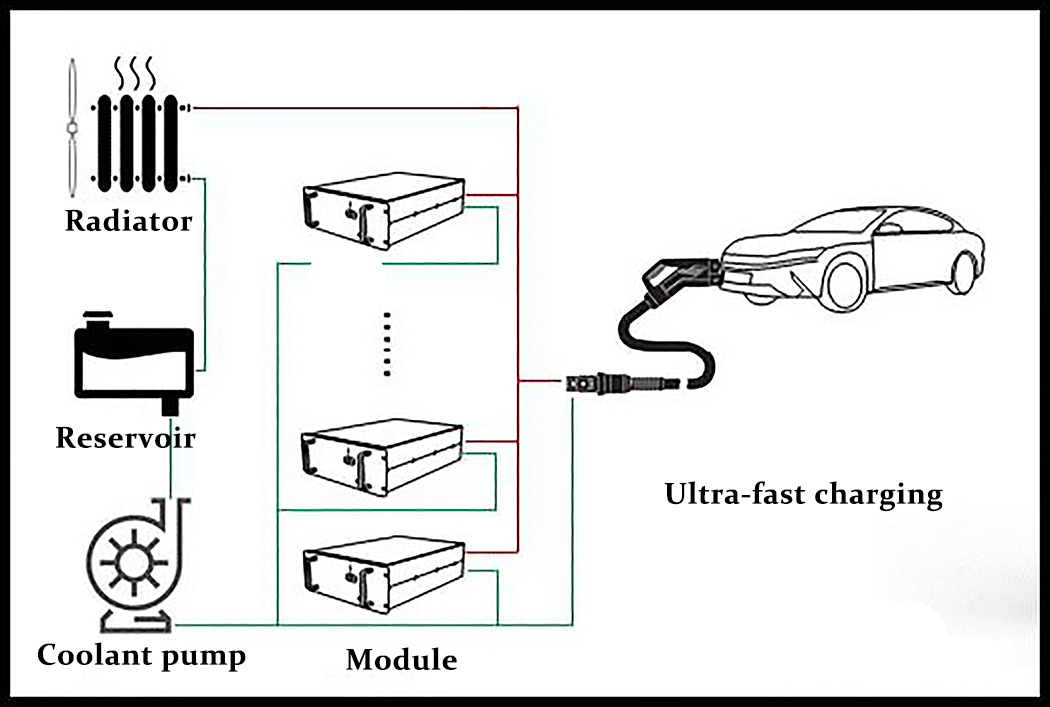Ultra-fast charging refers to the ability to recharge electric vehicle (EV) batteries or other battery-powered devices at significantly higher speeds than traditional methods. This technology aims to reduce charging times to just a few minutes, making it comparable to refueling a conventional gasoline vehicle.It’s an innovative method of accelerating EV charging by utilizing a liquid-cooling system. The core of the technology lies in a highly efficient liquid-cooling system, which consists of a number of key components, including radiators, coolant, coolant pumps, and piping networks.
Liquid-cooled ultra-fast charging refers to a system used to manage and dissipate the heat generated during the rapid charging of electric vehicle (EV) batteries. This technology employs a liquid cooling mechanism to maintain optimal temperature levels, ensuring safety, efficiency, and longevity of the battery and charging infrastructure.
The adoption of electric vehicles (EVs) is accelerating globally, driven by environmental regulations, consumer demand for sustainable transportation, and advancements in battery technology. The expansion of public and private charging infrastructure is critical to supporting the growing number of EVs. Charging networks are increasingly installing ultra-fast chargers to meet the needs of drivers who require quick recharging solutions.
Benefits of Liquid-Cooled Ultra-Fast Charging:
1. Higher current and faster charging speed.
Fully liquid-cooled ultra-fast charging are capable of delivering higher current and power compared to traditional charging piles and other fast/supercharging, which means faster charging speeds. In addition, fully liquid-cooled ultra-fast charging are designed to dissipate heat efficiently, allowing high-current transmission using smaller cross-sectional area cables. As a result, the cables of the fully liquid-cooled ultra-fast charging are thinner and lighter, and the charging gun is lighter, thus providing a better user experience.
2. Less heat generation, faster heat dissipation, high safety.
The coolant used in the fully liquid-cooled ultra-fast charging pile has a thermal conductivity that is dozens of times that of air, and the heat dissipation capacity of the liquid-cooled module can be reduced by 10-20℃ compared with that of the air-cooled module, which can significantly improve the cooling efficiency. In addition, the use of coolant reduces corrosion and damage to charging equipment.
3. Low charging noise and higher protection level.
Full liquid-cooling technology provides full wrap-around cooling, which enhances insulation and safety, enabling the charging pile to achieve high-level dustproof and waterproof performance of about IP65 of the international electrical standard, with higher reliability. In addition, the full liquid-cooled charging pile adopts a dual-circulation cooling architecture, the internal liquid-cooled modules rely on water pump-driven coolant circulation to dissipate the heat generated by the modules to the finned radiator, while the external one relies on low-speed, high-volume fans or air conditioners to dissipate the heat on the radiator, and the low-speed, high-volume fans are much lower in noise.
4. Easier maintenance and longer service life.
The design service life of fully liquid-cooled charging piles usually exceeds 10 years. In addition, compared with the air-cooled module charging pile needs to open the cabinet frequently for cleaning and maintenance, the maintenance of the full liquid-cooled charging pile is easier, and generally only needs to be cleaned when the external radiator accumulates dust.
